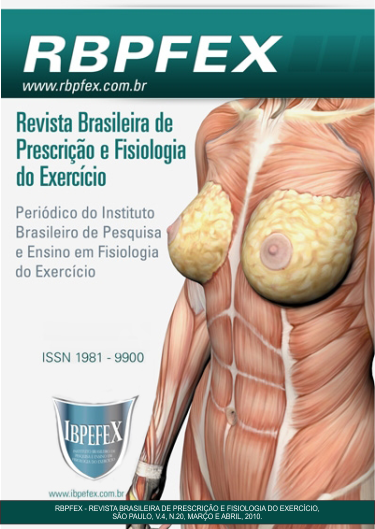Effect of the session of biodança in the glycemia of diabetic individuals of one Programs Health of the Family (PHF)
Abstract
Introduction: According to the Brazilian Society of Diabetes (SBD) physical activity can reduce glycemia to 70mg/dl and there may be a hypoglycemia, that with only one session of exercise. Purpose: To set itself the objective of this study to assess whether a meeting of biodança promotes glycemia response of subjects in middle-aged and elderly of a Family Health Program (PSF). Materials and Methods: The sample consisted of five subjects were female, aged from 54 to 78 years old, who participated in sessions of biodança, recreational activities and a walk, each lasting 30 minutes. Glycemic measures were taken at rest and immediately after each of these sessions, using a portable glicosímetro. Results: The results were analyzed and compared using descriptive statistics and the test Wilconxon (p <0.05). The glycemia in biodança, fell from 153.8 mg / dl to 142.8 mg / dl (p = 0138). Talk: Data from this study showed that there was a statistically significant decrease in relation to glycemic response. Despite the lack of significance, should be considered that only the fact that the glycemia falls (rather than increases) over this activity represents a significant clinical benefit for the subjects involved. This shows that the exercises are safe for diabetics. Conclusion: We conclude that these three activities promoting similar glycemic response, with a tendency to reduce acute glycemia.
References
- Demoradam, A.; e colaboradores. Therapeutic potencial of yoga practices is modifying cardiovascular risk profile in middle aged men na women. J Assoc Physicians Índia. Vol. 50. Num. 5. 2002. p. 633-640.
- Denadai, B. S. Avaliação Aeróbia: Determinação indireta da resposta do lactato sanguíneo. Rio Claro, São Paulo: Motrix, 2000.
- FIBGE (Fundação Instituto Brasileiro de Geografia e Estatística), 2000. Censo Demográfico de 2000. Rio de Janeiro: FIBGE
- Forjaz, C.L.M.; Cardoso, C.G.J.; Bisquolo, V.A.F.. Exercício Físico, Resistência á insulina e diabetes melito: efeitos agudos e crônicos, cuidados necessários. Revista da Sociedade de Cardiologia do Estado de São Paulo, Vol. 12 (supl. 5). Set-Out, 2002. p. 16-28.
- Forjaz, C.L.M.; Tinucci, T.; Alonso, D.O.; Negräo, C.E. Exercício físico e diabete. Rev. Soc. Cardiol. Estado de Säo Paulo. Vol. 8. Num. 5. set.-out. 1998. p. 981-990.
- Henrique, A.C.; Pozzebon, K.; Paulin, E. A influência do exercício aeróbio na glicemia e na pressão arterial de pacientes diabéticos. Arquivos de Ciências da Saúde UNIPAR. Vol. 7. Num. 2. Maio/ Agosto, 2003. p. 167-170.
- Riether, P.T.A. Efeito do exercício aeróbio e/ou associado à intervenção nutricional sobre o desempenho físico, adiposidade, glicemia e lipidemia de mulheres obesas em menopausa. São Paulo: 2002. Disponível em: http://bases.bireme.br/cgi-bin/wxislind.exe/iah/ online/. Acesso em: 11. março. 2007.
- Mercuri, N.; Arrechea, V. Atividade física e diabetes mellitus. Diabetes Clínica. Vol. 4. 2001. p. 347-349.
- Ministério Da Saúde. DATASUS. Estatísticas vitais – Mortalidade e nascidos vivos. Disponível em: http://portal.saude.gov. br/saude/. Acesso em: 12 março 2007.
- Moraes, C. Efeito do exercício aeróbio sobre os níveis séricos de leptina em mulheres obesas. 2004. 59 f. Dissertação (Mestrado em Ciência da Motricidade) – Instituto de Biociências, Universidade Estadual Paulista, Rio Claro, 2004.
- Negrão, C.E.; Rondon, M.U.P.B. Exercício físico, hipertensão e controle barorreflexo da pressão arterial. Revista Brasileira de Hipertensão. Vol. 8. 2001. p. 89-95.
- OMS. Organização Mundial de Saúde. Centro Brasileiro de Classificação de Doenças em Português. Sedentarismo. 10º rev. São Paulo: DUSP, 2005. 3 VOL.
- Ribas, A. Biodança. Uma porta para a vida. Brasília, 1994. Disponível em http://www.jperegrino.com.br/Terapias/o_principio_biocentrico.htm. A cesso em 10 de abril de 2007.
- SBME, SBGG. Atividade Física e Saúde no Idoso: uma posição da Sociedade Brasileira de Medicina do Esporte e Sociedade Brasileira de Geriatria e Gerontologia. Revista virtual EFArtigos, Natal/RN, Vol. 02. Num. 17, jan, 2005.
- Silva, O.F.A.; Silva, A.S.; Silva, J.M.F.L. Comportamento glicêmico em sessões de exercícios resistidos em diferentes momentos após ingesta de carboidratos. The FIEP Buletin, Foz do Iguaçú, p. 76, 2006.
- Silva, C.A.; Lima, W.C. Efeito benéfico do exercício físico no controle metabólico do diabetes mellitus tipo 2 à curto prazo. Arquivos Brasileiros de Endocrinologia Metabolismo. Vol. 46. Num. 5. outubro, 2002.
- Sociedade Brasileira De Diabetes. Consenso brasileiro sobre diabetes: diagnóstico e classificação de diabetes mellitus e tratamento do diabetes mellitus tipo 2. São Paulo: Sociedade Brasileira de Diabetes; 2004.
- Smeltzer, S.C.; Bare, B.G.; e colaboradores. Tratado de enfermagem médico-cirúrgica. Tradução: Figueiredo, José, E. F. Rio de Janeiro: Guanabara Koogan, 2005.
- Toro, R. Aspectos fisiológicos da Biodança. Biodança: Sistema Rolando Toro. Apostila do Curso de formação docente de biodança. Copryght by Rolando Toro Arañeda. Tomo I e II. Salvador: 2002 (Apostila)
Authors who publish in this journal agree to the following terms:
- Authors retain the copyright and grant the journal the right of first publication, with work simultaneously licensed under the Creative Commons Attribution License BY-NC which allows the sharing of the work with acknowledgment of the authorship of the work and initial publication in this journal.
- Authors are authorized to enter into additional contracts separately for non-exclusive distribution of the version of the work published in this journal (eg, publishing in institutional repository or book chapter), with acknowledgment of authorship and initial publication in this journal.
- Authors are allowed and encouraged to post and distribute their work online (eg, in institutional repositories or on their personal page) at any point before or during the editorial process, as this can bring about productive change as well as increase impact and impact. citation of published work (See The Effect of Free Access).






